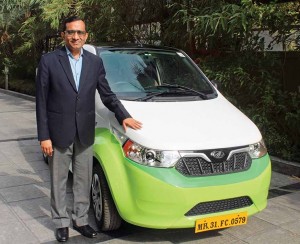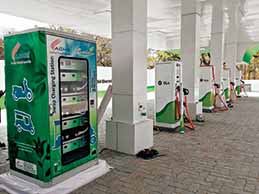The first Indian e-taxi has rolled out at Nagpur.
Story by:
Ashish Bhatia
As part of the Phase I of multi-modal electric vehicle pilot project, 100 e-taxis have hit the road at Nagpur. Operated by Ola Cabs, the e-taxis are four door Mahindra e2o Plus electric cars, painted in a shade of green and white. A reflection of Central Goverment’s aspiration to build electric mass mobility, the 100 e2o Plus e-taxis will add a unique blend to the city’s public transport structure. The home constituency of minister for road transport, Nitin Gadkari, Nagpur set the stage for ‘green’ public transport roughly three years ago when the first ethanol-powered Scania 12 m low-floor city-bus found its way to the city. More bio-fuel Scania city-buses are said to have been supplied to the city of Nagpur against an order for 55 such buses. The arrival of 100 e-taxis follows the announcement by NITI Aayog for a mass shift to electric vehicles by 2030. Expressed Devendra Fadnavis, Chief Minister, Maharashtra, at the e-taxi launch, “This pilot project will have a positive influence on the society.” To support the project, the state government is claimed to have waived off VAT, road tax, and registration charges. To help Maharashtra to be looked upon as a model state for others to emulate, the e-taxi pilot project is claimed to have lead the State to set aside an archiac rule that cars with engines below 900 cc cannot be registered as taxis.
Crucial to the proliferation of e-taxis will be the supporting infrastructure. Ola is claimed to have invested over Rs.50 crore towards the purchase of 100 e20 Plus, and to set up the charging infrastructure. If sources are to be believed, over 50 charging points have been installed across four strategic locations in the city. Highlighting its commitment to train and educate the driver partners on maintenance and use of electric-vehicle in association with its OEM partner, Ola Cabs has fixed a base fare of Rs.40, and a charge of Rs.8 for the first twelve kms. Beyond that the structure changes to Rs.12 per km. A ride time fare of one-rupee per minute will be charged as well. If the fare structure looks similar to that of an Ola prime sedan, and an Ola mini, it also highlights the fact that alternate fuel vehicles as a mass transport medium are yet to be ‘truly’ viable. If the absence of a cancellation charge, which is applicable for an Ola mini, at Rs.50, is a positive, the size of the e2o Plus means that three commuters can travel in good comfort, not including the driver. Four adult commuters is going to be a squeeze.
Measuring 3590 mm in length, 1575 mm in width, and 1585 mm in height, the e20 Plus compares well with an Ola mini, which is typically a compact sedan like the Hyundai Xcent and Ford Aspire. The Xcent measures 3995mm in length, 1660 mm in width and 1520 mm in height.
Powered by a 48 cell configuration, Lithium Ion battery of 210 Ah, the e20 Plus has an on-board power of 11 kWh. Using a three-phase AC induction motor, the e-taxi develops a peak power of 19 kW (25 hp) at 3500 rpm. It generates a torque of 70 Nm at 1000 rpm. Transmission is a two-speed direct-drive unit. Front suspension is made up of Mac Pherson struts, and coaxial springs. Rear has a twin pivot trailing arm with a coaxial spring and damper. On a full charge of 88 Wh, the e20 Plus covers 110 kilometres. Top-speed is 80 kmph. Acceleration from zero to 40 kmph is claimed to be 6.3 seconds. To charge the e20 Plus (up to 80 per cent), a 3 kW, single-phase, 16 Ampere charger is supplied. It takes approximately seven hours and twenty minutes. On a 10 kW, three-phase, 32 Ampere charger, the charging time reduces drastically. Ex-showroom price of the e20 Plus e-taxi at Nagpur is Rs.7,73,380 (inclusive of the FAME incentive), claim industry sources. A three year or 60,000 km warranty is offered.
Charging infrastructure
Solar power developer ACME Group has provided battery swapping and charging station ‘EcoCharge’ to taxi aggregator Ola for their pilot project at Nagpur. The new charging station is India’s first battery swapping and charging station for electric vehicles. It brings with it, advantages like lowest operating cost and fast charging. The time it takes to swap is less than it takes to fill fuel. The project, inaugurated by minister for road transport, Nitin Gadkari, is said to have commenced operations with over 50 charging points across four strategic locations at Nagpur. Sources at ACME indicate, that the company, with the new project, plans to replicate similar swapping and charging infrastructure in other cities of India in a bid to facilitate faster adoption of electric mobility. Expressed Manoj Kumar Upadhyay, Founder and Chairman, ACME Group, “I see a future of energy storage along with solar to provide 24×7 power and oil free transportation. This should help India solve problems like pollution, heavy dependency on oil import, and enable many industries to pro-actively generate employment opportunities.” ACME offers lithium batteries that have been developed in-house, and boast of intelligent BMS technology for electric mobility and stationary applications. With capacities ranging from kilo watt per hour to mega watt per hour, ACME has a lithium battery manufacturing facility at Rudrapur, in Uttarakhand.






















